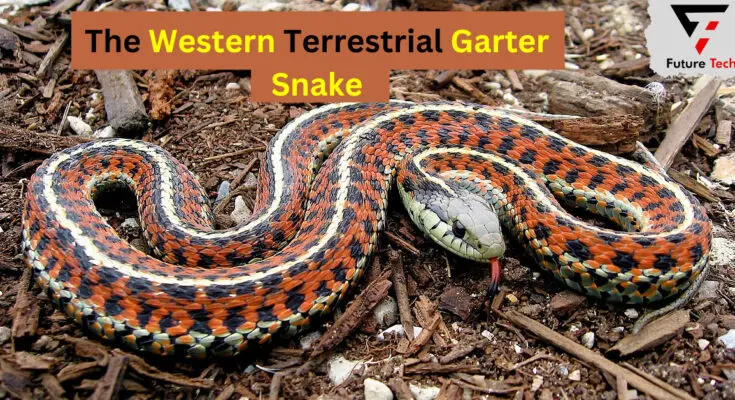The western terrestrial garter snake, also known as the terrestrial garter snake or Thamnophis elegans, is a fascinating reptile found throughout much of western North America. This article will examine this common yet underappreciated snake species’ habitat, behavior, reproduction, and other critical aspects. With their distinctive striped markings and mild venom, garter snakes play an important ecological role. – read on to learn more about the lives of these small serpents!
Why Learn About the Western Terrestrial Garter Snake?
While garter snakes may not seem as exciting as more extensive, more dangerous snake species, they are, in fact, one of the most widespread and adaptable reptiles in North America. Understanding the biology and ecology of common animals like the western terrestrial garter snake can provide essential insights into the health of local ecosystems. Additionally, garter snakes are mildly venomous – making them one of the few species found as far north as Canada. Their venom delivery system and hunting behaviors are fascinating topics for biologists and herpetology enthusiasts.
Overall, the terrestrial garter snake is iconic across much of western North America. Learning more about how these snakes live and thrive can deepen our appreciation for local biodiversity and the interconnectedness of prey and predator species.
Where Do Western Terrestrial Garter Snakes Live?
The western terrestrial garter snake lives across a large swath of western North America – from southwestern Canada through the western United States. Specifically, their geographic range extends from central British Columbia through the western halves of Washington, Oregon, and California. Their range reaches east into Idaho, Nevada, Utah, Arizona, and New Mexico. Isolated populations are as far east as western Oklahoma, Nebraska, and southwest South Dakota.
Within this broad region, terrestrial garter snakes occupy various habitats. They thrive in wetlands, stream corridors, ponds, meadows, and forests. These snakes adapt well to human disturbance – taking advantage of vacant lots, gardens, and city parks. Overall, terrestrial garter snakes are habitat generalists from sea level up to over 10,000 feet. Their adaptability helps explain their widespread success across western North America.
What Specific Habitats Do Terrestrial Garter Snakes Prefer?
While terrestrial garter snakes use diverse habitats, they prefer specific environmental conditions. These snakes are most strongly associated with:
- Wetlands and marshes – shallow, fish-free wetlands—offer ideal sheltering sites and amphibian prey for garter snakes.
- Stream and pond edges – shoreline habitats—provide cover and access to aquatic prey like frogs and salamanders.
- Low-elevation woodlands and forests – forests with ample understory cover and rodent populations—support high snake numbers.
- Parks, fields, and vacant lots – manufactured open spaces mimic natural meadows and provide refuge in developed areas.
Ideal habitats have hiding spots for thermoregulation (like rocks, logs, and caves), plenty of prey species, and suitable overwintering sites free from freezing. Proximity to water is a consistent component of top-quality garter snake environments.
What Do Terrestrial Garter Snakes Eat?
Garter snakes are opportunistic feeders that consume various small animal prey. Their diet commonly includes:
Amphibians – Frogs, toads, and newts make up much of the diet of juveniles and adults. Reptiles – Lizards and smaller snakes are also eaten. Rodents and birds – Small mammals and nestlings are taken occasionally. Invertebrates – Earthworms, leeches, slugs, and aquatic insects are eaten frequently—fish and fish eggs – are less common prey but are still part of the garter snake diet.
Younger snakes rely more heavily on cold-blooded prey like amphibians and invertebrates. As garter snakes mature, they shift to consuming more warm-blooded vertebrates like mice and birds. Garter snakes hunt during the day using chemical cues to locate prey. They kill prey through constriction and envenomation before swallowing animals whole. Their flexible jaws allow snakes to consume prey up to three times the size of their heads!
How Does the Western Terrestrial Garter Snake Reproduce?
Terrestrial garter snakes have fascinating reproductive behaviors centered around large mating congregations. After hibernation, males begin trailing female pheromones to breeding sites near water in spring. Dozens or even hundreds of garter snakes may converge at these mating sites. Females release potent pheromones that induce frenzied courtship activity by the males, which can last for several weeks. Male garter snakes often form large mating balls around a single female. The mating competition is intense, with each female generally mating with several males throughout a breeding season. After mating concludes in the early summer, female garter snakes can give birth to over 20 young. Unlike most snake species, garter snakes give birth to live young rather than laying eggs. The developing embryos are nourished via a placental connection.
The lifespan of garter snakes ranges from 2 to 5 years for males and up to 10 years for females. Many snakes fall victim to predators, disease, and cold stress – making successful reproduction essential to sustaining populations.
How Does Garter Snake Reproduction Differ from Other Snake Species?
Most snake species are oviparous – the female lays fertilized eggs that hatch later. Garter snakes are ovoviviparous – they retain the eggs inside their bodies and give birth to live young. Additionally, garter snake mating rituals involve large seasonal breeding gatherings. This contrasts with most snakes, which seek out mates on a chance basis.
Finally, promiscuous mating by both male and female garter snakes results in complex paternity within litters. The mating balls of dozens of male snakes around a single female appear unique to garter snakes.
Is the Western Terrestrial Garter Snake Venomous?
Garter snakes are considered mildly venomous, though not necessarily dangerous to humans. They produce a mild neurotoxic venom that paralyzes prey like amphibians and small rodents. The venom is delivered through tiny grooved teeth along the upper jaw. When garter snakes bite defensively, they may produce only minimal venom – saving their toxin for capturing prey. Therefore, garter snake bites on humans rarely cause significant symptoms beyond local swelling and discomfort. There are no confirmed reports of fatalities from garter snake bites, though individual sensitivity to snake venom can vary.
How Do Garter Snakes Use Venom When Hunting Prey?
Garter snakes use their venom to subdue and kill prey like frogs, toads, and small rodents. Combined with constriction, the venom allows garter snakes to immobilize prey quickly.
The neurotoxic venom blocks nerve impulses, paralyzing muscles and organs rapidly. This stops prey from being able to breathe or flee. The effects are fast but not strong enough to threaten the lives of healthy adult humans. Interestingly, newborn garter snakes possess more potent venom than adults. This stronger venom helps juveniles take down prey. Venom potency decreases over time as snakes mature.
What threats face the Western Terrestrial Garter Snake?
Though still widespread, garter snake populations face growing threats across their range. Major issues include:
Habitat loss – Draining of wetlands and development reduces habitat quality and connectivity. Vehicle strikes – Roads bisecting migration routes and habitat take a heavy toll. Pollution – Garter snakes are vulnerable to pesticides and other chemicals accumulating in prey species. Persecution – Many people kill garter snakes on sight due to fear and misunderstanding. Disease – Parasites and fungal infections may pose an increasing threat to some populations. Predators – Natural predators like birds, mammals, and other snakes help keep garter snake numbers in check. Habitat protection and public education can help ensure garter snakes remain a thriving part of North American ecosystems. These adaptable snakes continue playing their essential ecological role as predators and prey when left undisturbed.
10 Key Facts to Remember About the Western Terrestrial Garter Snake:
- Found across much of western North America, from Canada to Mexico
- Occupies diverse habitats, from forests to wetlands to city parks
- Feeds on a wide range of small animals, including amphibians, reptiles, and rodents
- Mildly venomous but generally harmless to healthy adult humans
- It gives birth to live young rather than laying eggs
- Mating involves large seasonal breeding balls and competition
- Females give birth to over 20 young babies after a 2-3 month gestation
- Lifespan ranges from 2 to 10 years, depending on sex and habitat quality
- Loss of wetland habitat is a significant threat across their range
- Supports ecosystem health by controlling amphibian and rodent populations
The terrestrial garter snake remains one of the most familiar and recognizable reptiles across the western United States and Canada. While often overlooked, garter snakes play critical ecological roles and have unique natural history traits. Hopefully, this overview has shed more light on the biology and importance of Thamnophis elegans across its range.
Conclusion:
The Western Terrestrial Garter Snake, scientifically known as Thamnophis elegans, is a captivating reptile found throughout western North America. This article delves into its habitat, behavior, reproduction, and ecological significance. Despite being mildly venomous, garter snakes play a crucial role in ecosystems, particularly the terrestrial variant. The article emphasizes the need to understand their biology for insights into local ecosystem health. The Western Terrestrial Garter Snake thrives in diverse habitats, adapting well to wetlands, meadows, and urban areas. Its diet is opportunistic, ranging from amphibians to rodents, with a unique reproductive behavior involving large mating congregations.
Unlike most snakes, garter snakes give birth to live young. The article highlights environmental threats such as habitat loss and pollution, stressing the importance of conservation efforts. Ten key facts summarize essential information about this snake, underlining its geographic range, habitat preferences, feeding habits, and ecological contributions. The Western Terrestrial Garter Snake emerges as a vital yet often overlooked component of western North American ecosystems, contributing to the delicate balance as both predator and prey.




